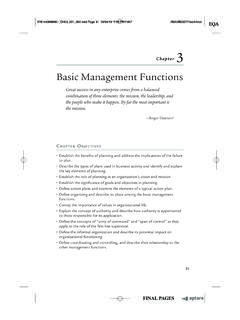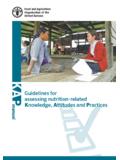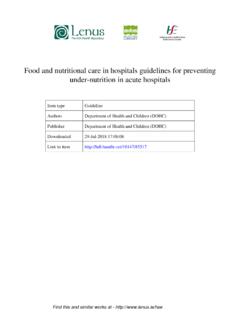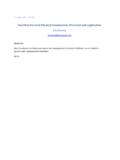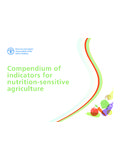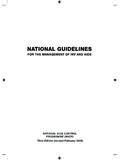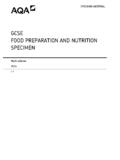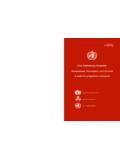Transcription of CHAPTER During Pregnancy - Jones & Bartlett …
1 77920_CH01_001_024_3 1/14/10 11:51 AM Page 1. CHAPTER . nutrition Requirements During Pregnancy 1. Lisa S. Brown, PhD, RD. With a Special Section: Unusual Complications of Pregnancy CHAPTER OUTLINE. Nutritional Status Prior to Pregnancy Common Problems Associated with Pregnancy The Fetal Origins Hypothesis Nausea and Vomiting of Pregnancy and Food Aversions and Cravings Nausea and Vomiting of Pregnancy Maternal Preconception Weight Status nutrition Requirements During Pregnancy Preexisting Conditions Cravings and Aversions Common Problems Associated with Public Health Campaigns to Improve Preconception Pregnancy Nutritional Status The Interaction of Life-style and Pregnancy General Preconception Health and nutrition Physical Activity, Safety, and Energy Needs Food Safety Recommendations for Women Alcohol Illegal Drug Use Cigarette Smoking Caffeine Nutrient Needs During Pregnancy Special Section.
2 Unusual Complications of Pregnancy Total Energy Protein Lipids and Fats Essential Fatty Acids Pica Preeclampsia Gestational Diabetes Choline Fiber Carbohydrate Vitamin A Vitamin D. Calcium B Vitamins Vitamin B12 Folate Iron Magnesium Zinc Iodine Fetal Development The Embryonic Phase The Fetal Phase Critical Periods of Nutrient Intake During Embryonic and Fetal Development 1. Jones and Bartlett Publishers, LLC. NOT FOR SALE OR DISTRIBUTION. 77920_CH01_001_024_3 1/14/10 11:51 AM Page 2. Reader Objectives After studying this CHAPTER and reflecting on the contents, you should be able to 1. Discuss the rationale for healthy nutrition During Pregnancy . 2. Summarize the growth changes that occur During fetal development.
3 3. Discuss the common nutrition -related problems that can occur During Pregnancy . 4. Explain the complications of Pregnancy . 5. Summarize how life-style choices can affect fetal development. What a woman eats when she is pregnant can have profound and lasting effects on her child's health. The ex- pression you are what you eat applies, but in this case, it is this: You are what your mother eats. During the pre- natal period, the fetus has the enormous task of evolving in only 9 short months from a single-celled, fertilized egg to a human infant. In order to accomplish this, the fetus must have all of the necessary resources available in the proper quantities and at the exact times they are needed. Despite the daunting nature of the task, mothers have been producing healthy infants for thousands of years, demonstrating the amazing adaptability of both the mother and her child.
4 The capacity of the mother's body to create the necessary conditions for fetal growth is one of the great miracles of life. There are limits, however, and the health of the child may suffer in obvious and not- so-obvious ways if certain thresholds for nutrients are not met. Although a pregnant body has an amazing ability to compensate for nutrient deficiencies and excesses, a woman cannot provide essential nutrients for her child if she herself is deficient in them. Many factors influ- ence a mother's nutritional status During her Pregnancy . The mother's own health before conception, her health During Pregnancy , her life-style choices, and environmental exposures can all change what and how much she eats and limit precious nutrients available for the growing fetus.
5 It is important that knowledgeable health care providers are available to support the mother-to-be with strategies to help her achieve the most balanced diet possible, thus ensuring the health of both mother and child. This CHAPTER examines normal prenatal nutritional requirements and common factors that may compro- mise the mother's ability to provide ideal nutrition for her growing fetus. Nutritional Status Prior to Pregnancy The period when a woman is pregnant is often looked at in isolation and is not put in a larger context of the mother's overall health. Although this has been the traditional approach to Pregnancy , there is a grow- ing movement to look at human nutrition using the life-course approach, which is promoted by the World Health Organization (WHO).
6 Using the life-course approach, a woman is followed from her own con- ception through death, and factors that have influenced her health since she herself was in utero are considered when assessing risk of developing chronic diseases for both the mother and her offspring (Darnton-Hill et al., 2004). The Fetal Origins Hypothesis The mother's health before and During Pregnancy may be affected by genetics, as well as malnutrition, acute and chronic disease, exposure to environmental toxins, and a number of other factors. The fetal origins hypothesis proposes that certain genes in the fetus may or may not be turned on depending on the environment that the mother is exposed to while pregnant (Hampton, 2004). For example, if a mother is exposed to severe food restriction During Pregnancy , as was the case in the Dutch famine dur- ing World War II, her developing fetus will adapt genetically to thrive in an environment of severe en- ergy restriction.
7 The child's genetic programming will be sensitized to store fat more efficiently compared with that of people not exposed to famine in utero. If the environmental conditions the child is born into 2 CHAPTER 1 nutrition Requirements During Pregnancy Jones and Bartlett Publishers, LLC. NOT FOR SALE OR DISTRIBUTION. 77920_CH01_001_024_3 1/14/10 11:51 AM Page 3. do not match the famine conditions, the child will accumulate fat more quickly than desired and be at higher risk for obesity, diabetes, and cardiovascular disease. Findings from the Dutch famine and other cohorts support the fetal origins hypothesis, and research is ongoing to confirm the process by which this may have occurred (Roseboom et al., 2006; Thompson, 2007).
8 In the World Health Organization's life-course approach to disease prevention, the passing on of ex- cess risk for chronic disease from mother to child based on prenatal environmental exposures is known as the intergenerational effect. The intergenerational effect is thought to be one reason behind the clus- tering of chronic disease risk factors in families of lower socioeconomic status. Women in lower socio- economic classes are more likely to be exposed to extreme environmental conditions and have substandard health care that exacerbates problems. Interventions should seek to maximize the mother's health be- fore and During Pregnancy to improve the short- and long-term health of her children. Maternal Preconception Weight Status Many aspects of the mother's health and life-style before Pregnancy have been shown to affect her sub- sequent pregnancies with potential to impact the health of her children, but one area of particular con- cern is the mother's weight before Pregnancy .
9 The dramatic increase of overweight and obesity in women in the United States has forced many health care providers to focus their counseling on weight manage- ment before and During Pregnancy . Preconception obesity has been associated with a substantial increase in risk for Pregnancy complications, such as gestational diabetes and preeclampsia, as well as a signifi- cant increase in birth defects (Chu et al., 2007; Hauger et al., 2008; Stothard et al., 2009). Both maternal obesity (body mass index [BMI] > 30) and maternal overweight status (BMI 25. to ) have been shown to increase the risk of birth defects. One study from the Centers for Disease Control and Prevention (CDC) found that babies born to mothers who were overweight at the time of conception had a higher risk of birth defects than those born to normal-weight women, and twice the risk of heart abnormalities.
10 Mothers who were obese prior to conception were more than 3 times as likely to have babies with spina bifida or the abdominal malformation omphalocele (Watkins et al., 2003). A mother who is underweight prior to becoming pregnant also puts her baby at higher risk for complications, mainly because of the association between underweight status and malnutrition (Ehren- berg et al., 2003). As discussed earlier, maternal malnutrition During Pregnancy may influence fetal pro- gramming, priming the child to be more susceptible to heart disease, diabetes, and high blood pressure later in life. Malnutrition may be due to illness, food insecurity, or other factors, and both the malnutri- tion and the underlying cause need to be addressed to maximize positive outcomes for both mother and baby.









